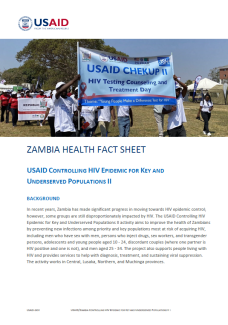In recent years, Zambia has made significant progress in moving towards HIV epidemic control; however, some groups are still disproportionately impacted by HIV. The USAID Controlling HIV Epidemic for Key and Underserved Populations II activity aims to improve the health of Zambians by preventing new infections among priority and key populations most at risk of acquiring HIV, including men who have sex with men, persons who inject drugs, sex workers, and transgender persons, adolescents and young people aged 10 - 24, discordant couples (where one partner is HIV positive and one is not), and men aged 25 - 34. The project also supports people living with HIV and provides services to help with diagnosis, treatment, and sustaining viral suppression. The activity works in Central, Lusaka, Northern, and Muchinga provinces.
GOALS
Goal one
- Identify individuals at high risk of HIV infection and connect them with high-impact HIV prevention services such as HIV counseling and testing, pre-exposure prophylaxis (HIV prevention medication), and condoms.
Goal two
- Identify and link people living with HIV to HIV treatment and care services to support epidemic control.
Goal three
- Provide communities with the knowledge and skills to implement community-driven interventions to address the root causes of the HIV epidemic such as early sexual debut (age of first sexual activity), sexual and gender-based violence, and poverty.
Goal four
- Build the skills and knowledge of local implementing partners to provide targeted, evidence-based HIV prevention services.
KEY RESULTS FOR 2023
- Almost 430,000 key and priority populations were reached with high-impact HIV prevention services such as HIV counseling and testing, pre-exposure prophylaxis (HIV prevention medication), and condoms.
- Almost 55,700 people were tested for HIV, and out of those almost 3,030 were identified as HIV positive and immediately linked to HIV treatment.
- More than 15,000 self -test kits were distributed making it easier for people to test themselves for HIV at their convenience.
- More than 52,500 orphans and vulnerable children were reached with HIV prevention services.
|

